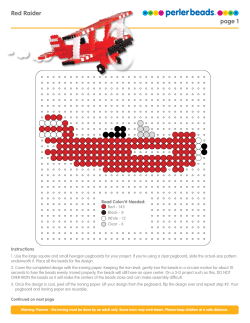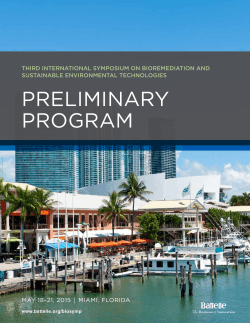
Why we need upscaling to describe microbiological processes in groundwater:
Why we need upscaling to describe microbiological processes in groundwater: Examples from fractured porous media and bioaugmentation technologies P.J. Binning Two problems where upscaling is needed Bioaugmentation Enhanced biodegradation in clays Non detect % Water supply wells with pesticides Pesticide contamination of groundwater 100 % 0% GEUS, 2006, 2009 Bioaugmentation “the technique for improvement of the capacity of a contaminated matrix (...) to remove pollution by the introduction of specific competent strains or consortia of microorganisms” Shimidzu et al. 2002 (El Fantroussi and Agathos, Curr. Opin. Microbiol. 2005) Boldt et al. 2004 liquid microbial activated soil culture immobilized microbes microbes with mobile genes rhizosphere biaogumentation phyto-augmentation Immobilized microbes Simazine (mg kg-1) • simazine, agricultural soil • 50% water saturation • 2-mm alginate beads • Pseudomonas sp. MHP41 120 100 80 Data 60 Model 40 20 0 Morgante et al. (2010) FEMS Microbiol. Ecol. 71:114-126 0 5 10 15 20 25 30 Time (day) Linuron Herbicide used since 1965, now banned in 7 of 27 EU countries Suspected developmental or reproductive toxin First-order mineralization rate C = C0 exp(− kt ) Variovorax sp. SRS16 k=0.216 day-1 80 60 40 20 14 CO2 (% of initial 14C) 100 0 0 96 192 288 384 480 Time (h) Reaction time scales about 5 days Diffusive transport ∂ (θ w + K H θ a )Cw − ∇ • (θ w Dw + K H θ a Da )∇Cw + θ w kCw = 0 ∂t Expected diffusive time scales 17 days for 20mm bead separation Mineralization time scale 10 105 Time (day) 20 years 1 year 90% removal, 2mm beads 6 104 saturation 100% 35% 10% 103 102 5 10 15 20 25 Bead spacing (mm) 30 A simple mixing model mθ w,bVb mθ w,sVs dm = − kb − ks = −keff m dt Vb + Vs Vb + Vs keff = θ w,b kbVb + θ w,s k sVs Vb + Vs m = m0 exp(− keff t ) For Vb/(Vs+Vb)=1% reaction rate reduced by a factor of 100 Vs Vb Simple mixing model 2mm beads, 100% saturation 100 -1 106 -2 105 keff (day-1) 10 keff 10 t90 10-3 104 10-4 103 10-5 102 10-6 101 Degradation rate for soil 100 10-7 0 20 40 60 80 Bead spacing (mm) 100 t90% (day) Degradation rate in beads Application of technology Require ~24 tons 2mm beads for 1 ha to remove 90% linuron in 100 days www.geograph.org.uk/photo/39325 (spaced at <10 mm in a layer of 100 mm) Effect of water infiltration ∂ (θ w + K H θ a )Cw ∂C − ∇ • (θ w Dw + K H θ a Da )∇Cw + qw w + θ w kCw = 0 ∂t ∂z Effect of water infiltration Reduction in outlet concentration 1,0 C/C0 0,8 column 18.5 cm Increasing column length, decreasing bead density 0,6 0,4 100% Saturation 35% 100% 35% 10% 0,2 10% 0,0 5 10 15 20 25 Bead spacing (mm) 30 Effect of cell dispersal experimental mineralization rate (% of benzoate mineralized per day) 70 7% 27% 68% 60 50 full colonization =bugs everywhere 40 30 20 10 minor colonization =bugs in beads 0 0.0 0.5 1.0 1.5 2.0 2.5 3.0 mineralization rate predicted by the model (% of benzoate mineralized per day) Dechesne et al. (2010) Env. Sci. Technol. 44:2386-2392 Conclusions Bioaugmentation has poorer performance in field than expected from lab results Models developed to predict field performance • Simple Mixing Models: Can upscaling help here? • Process models Soil moisture, infiltration and other environmental conditions affect performance Cell dispersal may potentially improve the technology (observed in sand, but limited in soil) Enhanced biodegradation in clays Clayey till Sand aquifer Chalk aquifer •Long term secondary source of contamination! •Remediation of chlorinated solvents? •Stimulated Reductive Dechlorination, SRD? DTU og Orbicon Geological characterization Geostatistical tools Hydrogeological model Modeling of SRD in clay till Optimization of enhancement Spreading of reagents Injection methods Biogeochemical site characterization Remediation design Practical tools Microbial and chemical process understanding What do clays look like? Fracture mapping Christiansen et al. (2008). ES&T, 42, 570–576. Sand lenses Fracture distribution – Field data Cumulative fracture spacing (average distance between vertical/sub-vertical fractures) Depth m below ground surface (m) 0 0 0,5 1 2 1,5 2,5 0.5 1 1.5 2 2.5 1 3 3.5 4 4.5 5 5.5 2 6 6.5 7 7.5 8 8.5 3 3m Location Silstrup Mammen Højstrup 2 Højstrup Gjorslev Avedøre Ranzausgade Flakkebjerg Havdrup Vasby Slæggerup Haslev 2 Fårdrup Estrup Gedser Grundfør Lillebæk Sigerslev 2 Ringe Kamstrup Tune Sigerslev 1 Haslev 1 1 2 3 SprækkeJAGG, 2008 Klint, 2001, PhD Thesis Anaerobic dechlorination Various microorganisms Only Dehalococcoides species Model system - simplification Model developed in Comsol Multiphysics ERD injection of donor and bacteria fractures Injection depths Contaminant mass in matrix Sum of chlorinated ethenes: TCE, DCE and VC Mass in matrix Full scale application of enhanced reductive dechlorination in clayey till (Sortebrovej, Denmark) Anaerobic dechlorination associated with sandstringers in clayey till Clay core Chlorinated ethenes [mg/kg] 0 1 2 3 4 5 6 Depth [m bgs.] 14,2 14,3 14,4 14,5 14,6 14,7 TCE cis-DCE VC Ethen 7 8 Modeling - scenarios Injection of donor in high permeability conduits Specific degraders only related to sandstringers or fractures Reaction zones surrrounding sandstringers 1m Base line – no dechlorination RZ10 – 10 cm reaction zone RZ30 – 30 cm reaction zone RZ60 – 60 cm reaction zone Best case – entire matrix Generation of degradation products – treatment area Before remediation RZ30 5 year after start of remediation Comparison with field data Degree of dechlorination 2 years after remediation Mass of contaminants in treatment area Start of remediation at day 0 Case study challenges: How do we model geology? How do we model hydraulics, including injection of substrate? Where are the bugs? How do we model the biogeochemistry? Acknowledgements Part 1 M. Owsianiak, A. Dechesne, B.F. Smets Mikołaj Owsianiak, Arnaud Dechesne, Philip J. Binning, Julie C. Chambon, Sebastian R. Sørensen, Barth F. Smets, Evaluation of Bioaugmentation with Entrapped Degrading Cells as a Soil Remediation Technology, Environmental Science and Technology, 44, 19, 76227626, doi: 10.1021/es101160u, 2010. Part 2 Julie Chambon, Gabriel Manoli, Philip Binning, Ida Damgaard, Mette Broholm, Camilla Christiansen, Gitte Lemming, Poul L. Bjerg Julie C. Chambon, Mette M. Broholm, Philip J. Binning and Poul L. Bjerg, Modeling multicomponent transport and enhanced anaerobic dechlorination processes in a single fracture – clay matrix system, Journal of Contaminant Hydrology,112, 1-4, 77-90, 2010.
© Copyright 2025





















